I am going to take a gamble that not everyone reading this issue of Salmonfly.Net is a grizzled veteran salmon fisher. No doubt many experienced salmon types are perusing the site but this writing is directed toward the new people; some of whom may be planning a first excursion for salmon. However even the experienced may find something useful within my musings here.
If you are used to fishing for trout with wet flies then you have had some pretty good training because salmon fishing often takes the form of nymphing or traditional wet fly / streamer fishing. As you are preparing your tackle for the trips don’t forget to take your stealth along it will come in handy. Fly casting for salmon does not always mean a double haul cast. 90% of the salmon I catch are within 20 - 30 feet of my position. I maintain a low profile while searching for fish and use all forms of stream side cover while scanning the water. After locating fish I move very slowly and do my best to look innate. Cryptic clothing is a must, (no bright colors) and precise casting allowing for the proper depth and drift to be attained at the target is a must. In short there is more to consistent success than meets the eye. As you will see as you continue reading, finding fish is important but it is only the tip of the proverbial iceberg.
Admittedly I have not spent an inordinate amount of time reading
about salmon fishing but I have done some. I have learned what I
know by fishing, and some lessons came the hard way. Early on I did
seek out some literature on the sport, and in reflecting back I
don’t remember any moments of epiphany regarding my reading. Many
texts described the slashing runs, the line slicing through the
water and the whine of the drag. Indeed these are sometimes the
components of the action that follows hooking a large fish. I will
submit to you here that while this sounds exciting and perhaps is
part of the romantic draw of the salmon fishing experience; many of
the fish that provide the subject matter for such writings may never
be landed. The longer you take to land a fish the greater the
odds of losing it. Remember this, the further you let one
get from your rod tip the further you are from catching a salmon.
Something I believe gets buried in the prolific information
available to the reader regarding salmon fishing is what to do after
the moment has arrived; you have a nice one hooked, now what?
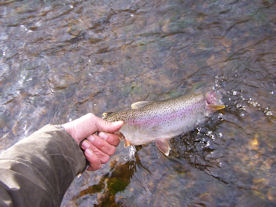 Everyone
has their own specific preference for hooking, fighting, and landing
a salmon. I began to fish for salmon in 1980 and in that first year
was fortunate enough to hook, play, and land several Salmon in the
waters of coastal Maine.
Once while struggling with a fish in the 10lb class an older
gentleman was kind enough to attempt netting it for me. Each time
the fish was near enough for him to thrust his net after it, the
fish would bolt and I would allow another line ripping, scorching
run. When we finally managed to get the fish into the net that
gentleman looked at my leader as it protruded from the fishes jaw
and asked, "What the H*** are you using for a leader?" I told him
“an 8 pound tippet” and then he literally bellowed at me “For God's
sake man, what are you thinking? You're fishing for a fish that can
run 20 pounds! Are you here to catch em or torture them, eh?" This
incident made a lasting impression on me and I have never
under-lined myself when fishing for salmon since. I seldom fix a
leader to my line under 15 pound test and more often I go with 20.
Here I must add that I cannot emphasize enough to double check
those knots! Some days salmon are so hard to find that after
hiking and fishing for hours on end, it would be unforgivable to
locate fish only to have them break off from an 8 pound leader or a
bad knot on an otherwise good heavy leader. For kings I use 25 pound
leader and in many instances I am under-lined. The choice of leader
for kings presents a special conundrum. Your backing better be
stronger than your leader or you risk losing the works to a fish. I
use 36 pound backing so that the 25 pound leader gives me an 11
pound margin of error before a Kenai King heads down river with my
SA Mastery DT 9 in tow. When fishing sockeye, chum, or silver
salmon I generally employ 15 - 20 lb. test fluorocarbon. Pink salmon
are my only light tackle salmon species and still I am lined with 12
lb. test. For steelhead in low clear water while using smaller low
water patterns I use 8 lb. fluorocarbon as my leader.
Everyone
has their own specific preference for hooking, fighting, and landing
a salmon. I began to fish for salmon in 1980 and in that first year
was fortunate enough to hook, play, and land several Salmon in the
waters of coastal Maine.
Once while struggling with a fish in the 10lb class an older
gentleman was kind enough to attempt netting it for me. Each time
the fish was near enough for him to thrust his net after it, the
fish would bolt and I would allow another line ripping, scorching
run. When we finally managed to get the fish into the net that
gentleman looked at my leader as it protruded from the fishes jaw
and asked, "What the H*** are you using for a leader?" I told him
“an 8 pound tippet” and then he literally bellowed at me “For God's
sake man, what are you thinking? You're fishing for a fish that can
run 20 pounds! Are you here to catch em or torture them, eh?" This
incident made a lasting impression on me and I have never
under-lined myself when fishing for salmon since. I seldom fix a
leader to my line under 15 pound test and more often I go with 20.
Here I must add that I cannot emphasize enough to double check
those knots! Some days salmon are so hard to find that after
hiking and fishing for hours on end, it would be unforgivable to
locate fish only to have them break off from an 8 pound leader or a
bad knot on an otherwise good heavy leader. For kings I use 25 pound
leader and in many instances I am under-lined. The choice of leader
for kings presents a special conundrum. Your backing better be
stronger than your leader or you risk losing the works to a fish. I
use 36 pound backing so that the 25 pound leader gives me an 11
pound margin of error before a Kenai King heads down river with my
SA Mastery DT 9 in tow. When fishing sockeye, chum, or silver
salmon I generally employ 15 - 20 lb. test fluorocarbon. Pink salmon
are my only light tackle salmon species and still I am lined with 12
lb. test. For steelhead in low clear water while using smaller low
water patterns I use 8 lb. fluorocarbon as my leader.
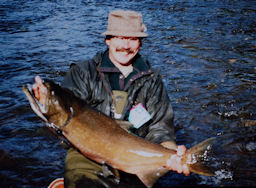 When
I lived in Pennsylvania and fished
the Great Lakes tributaries I read
a few articles regarding how to catch the fish there. The
recommendations were almost unanimous for using lighter leaders and
small flies. The consensus seemed to be that the fish were leader
shy. At least that is what I took from the reading; often I wondered
how a fish that has been out in deep water in Lake
Ontario
or in the ocean for that matter gets leader shy? I was even advised
by fly shops that a heavy line would result in fewer hookups. Of
course I bucked the system and found that the only times I failed to
catch fish one or both of the following conditions existed; if there
were no fish present in the area, I caught nothing. If the fish were
present but under so much fishing pressure that they were simply
terrified and would take nothing except shelter, I caught nothing.
When I encountered optimum conditions of many fish and fewer people
I could not get them in fast enough! This leads to the most
important part of this writing, what you do after the hookup.
When
I lived in Pennsylvania and fished
the Great Lakes tributaries I read
a few articles regarding how to catch the fish there. The
recommendations were almost unanimous for using lighter leaders and
small flies. The consensus seemed to be that the fish were leader
shy. At least that is what I took from the reading; often I wondered
how a fish that has been out in deep water in Lake
Ontario
or in the ocean for that matter gets leader shy? I was even advised
by fly shops that a heavy line would result in fewer hookups. Of
course I bucked the system and found that the only times I failed to
catch fish one or both of the following conditions existed; if there
were no fish present in the area, I caught nothing. If the fish were
present but under so much fishing pressure that they were simply
terrified and would take nothing except shelter, I caught nothing.
When I encountered optimum conditions of many fish and fewer people
I could not get them in fast enough! This leads to the most
important part of this writing, what you do after the hookup.
My style of hooking and landing a
salmon (any species) is all about getting the fish on the beach.
If I can do so without the fish making a single run I have done an
outstanding job of catching a salmon. There is no need for using
a light leader and thus allowing the fish to make run after run
based on the argument that you can't stop them. Even with a heavy
line as a leader the runs will occur. Some fish just plain take off
and you cannot turn them before they bolt. In this scenario having a
heavy leader will help you to avoid the demeaning and often
dangerous run down the shoreline. You will be able to pressure and
turn the fish, maybe just not as quickly as you would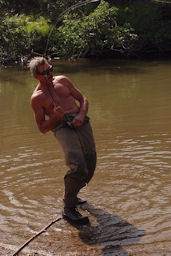 like. I should add that this does
sometimes require that you follow the fish rapidly but safely in the
direction of the run in order to attain a position perpendicular to
it so that you can exert the side pressure needed to turn it. Now
the real strategy begins! Once you have stopped the mad dash, many
times the fish may come toward the surface. If it does not then you
must use the angle of your rod and the pressure allowed by your
leader to lift the fish through the water column to the surface. Why
is this important? A simple matter of hydro physics is at play here.
If you were in a swimming pool and wish to make a swift sweeping
action with your right arm is it easier at the surface level or at a
depth of four feet? The deeper you allow the fish to remain in the
water column the more pressure and resistance you will feel on your
end of the rod and the fish will have the upper hand. So bring
them up! When the fish breaks the surface you should apply immediate
tension with a side pull or sweep of the rod at about waist level.
This action will in all but the extreme cases move the fish toward
your position head first; in the best circumstance you want to be
skidding that fish towards you as well as can be accomplished.
The act of bringing the fish to shore head first is simply the best
approach due to the fact that they do not swim backwards well. With
this accomplished what remains for you is to alternate your rod
angle as needed from high to the waist level pumping sweeping action
and reel in the slack with each successive pump of the rod. As you
move the rod tip toward the fish for another pull on the rod you
want to be reeling as
like. I should add that this does
sometimes require that you follow the fish rapidly but safely in the
direction of the run in order to attain a position perpendicular to
it so that you can exert the side pressure needed to turn it. Now
the real strategy begins! Once you have stopped the mad dash, many
times the fish may come toward the surface. If it does not then you
must use the angle of your rod and the pressure allowed by your
leader to lift the fish through the water column to the surface. Why
is this important? A simple matter of hydro physics is at play here.
If you were in a swimming pool and wish to make a swift sweeping
action with your right arm is it easier at the surface level or at a
depth of four feet? The deeper you allow the fish to remain in the
water column the more pressure and resistance you will feel on your
end of the rod and the fish will have the upper hand. So bring
them up! When the fish breaks the surface you should apply immediate
tension with a side pull or sweep of the rod at about waist level.
This action will in all but the extreme cases move the fish toward
your position head first; in the best circumstance you want to be
skidding that fish towards you as well as can be accomplished.
The act of bringing the fish to shore head first is simply the best
approach due to the fact that they do not swim backwards well. With
this accomplished what remains for you is to alternate your rod
angle as needed from high to the waist level pumping sweeping action
and reel in the slack with each successive pump of the rod. As you
move the rod tip toward the fish for another pull on the rod you
want to be reeling as
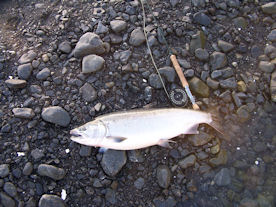 fast as you can. The final
step to take in order to insure that the fish does not execute any
last second heroics is to forget about netting the fish. If the
shoreline will allow for you to move back away from the water while
continuing to pump and reel the fish to shore then get back! I have
already landed king salmon from 5 yards deep in the brush along some
of my favorite rivers. Of course this discussion has not covered
every aspect of what can happen when you are hooked to 20 lbs. of
lightening for the first time or your tenth time. There are
submerged logs and all sorts of obstacles that can interfere with
your success including a knot that is not properly tied and tested.
Taking control and doing so quickly with a leader that is up
to the task will stack the odds in your favor.
fast as you can. The final
step to take in order to insure that the fish does not execute any
last second heroics is to forget about netting the fish. If the
shoreline will allow for you to move back away from the water while
continuing to pump and reel the fish to shore then get back! I have
already landed king salmon from 5 yards deep in the brush along some
of my favorite rivers. Of course this discussion has not covered
every aspect of what can happen when you are hooked to 20 lbs. of
lightening for the first time or your tenth time. There are
submerged logs and all sorts of obstacles that can interfere with
your success including a knot that is not properly tied and tested.
Taking control and doing so quickly with a leader that is up
to the task will stack the odds in your favor.
I
realize that the preceding text is based on my own experience and is
quite opinionated. The techniques which I have tried to describe for
you work and they work time after time for me; this is why I believe
they are worth sharing. Here in
Alaska
I seldom find myself fishing where I can expect to catch small fish.
Not that some 12 – 15 inch trout and 2 – 3 pound jack salmon don’t
find their way onto the fly every year but the majority of fish
caught are in the 8 – 25 pound range. It is because of the number of
fairly large fish I land each season that I feel I have a good base
of knowledge regarding how to get them on the shore. If you are
already skilled at landing large fish then you knew all of this, but
if you are new to the game I would advise saving the issue and
reviewing it prior to getting hooked up, I’m sure it will help.
The Flies






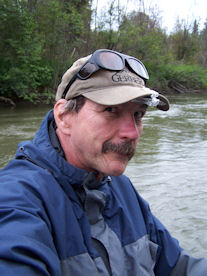
The
Real Skinny, is a regular feature of informative
articles written by Ard Stetts for Salmonfly.Net about fly fishing
for salmon and steelhead. Ard Stetts was born in north
central Pennsylvania and now resides in Alaska with his wife Nancy. He has been tying
classic Salmon, Landlocked Salmon and Featherwing Trout Streamers
for 35 years and has learned from some of the best. Also see
The Flies of
Ard Stetts.